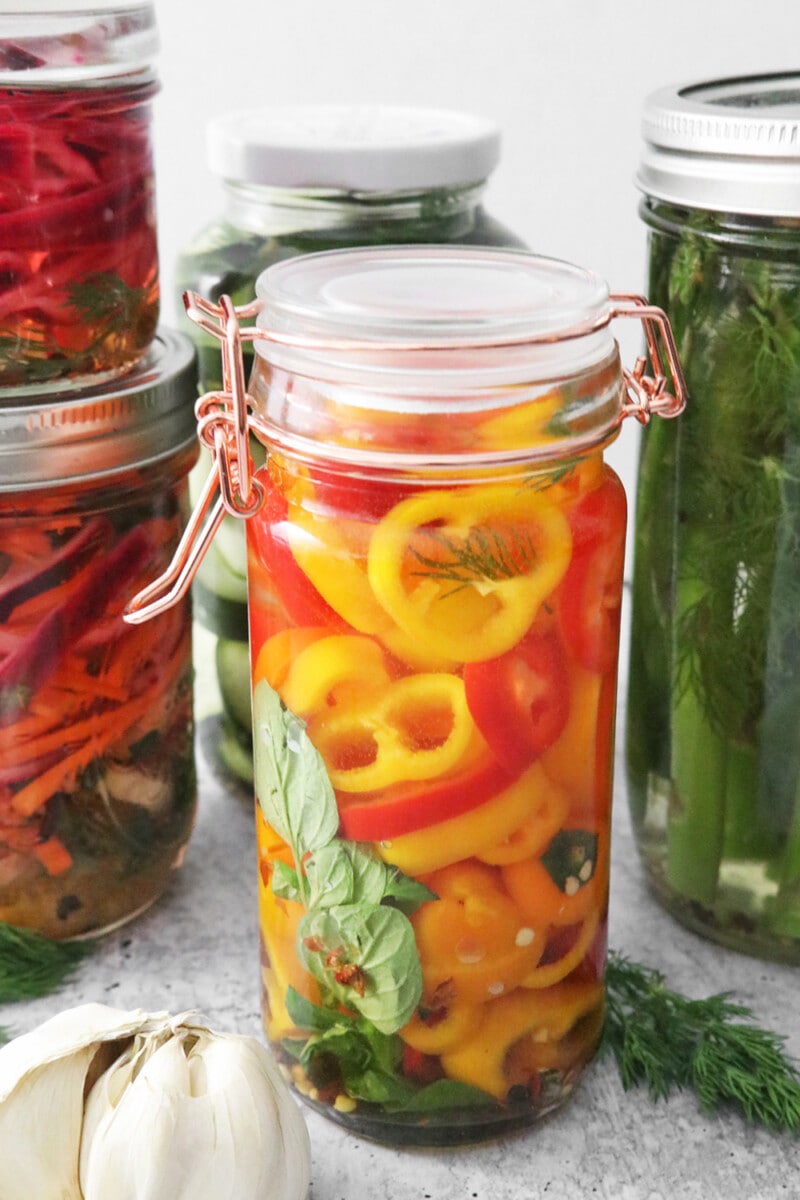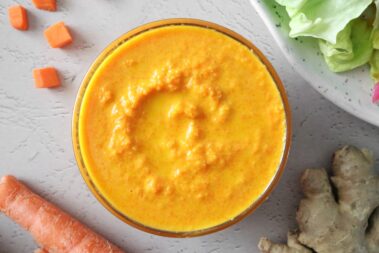
From hearty tofu sandwiches to freshly tossed salads, almost every meal tastes better with pickled vegetables. This is especially true if the pickles are homemade, because everything tastes better when it’s made from scratch. The only drawback? Making shelf-stable pickles requires canning with special equipment, so it might not be the most accessible project for everyone.
Enter quick pickles, also known as refrigerator pickles. Quick pickles are vegetables that are soaked in a brine for a short time, about 1 or 2 hours. They’re also called refrigerator pickles because the brining process takes places in the refrigerator.
And though pickles are typically associated cucumbers, you’re not limited to the vegetable. You can pickle almost any veggie, from asparagus to onion.
Read on to learn how to quick pickle vegetables, plus tips and quick pickle seasoning ideas.
Table of Contents
Key Ingredients

- Vegetables. Choose your favorite! Cucumbers, carrots, and beets are popular choices. You can even combine multiple types of vegetables in one jar.
- Vinegar. A quick pickle brine is made of vinegar and water. White vinegar is the most common option, but you’re welcome to use red wine vinegar, rice vinegar, or apple cider vinegar, or even a combination of different types.
- Salt. Salt will help bring out the natural flavor of vegetables while adding that iconic pickle taste. Be sure to use pickling salt, pure sea salt, or kosher salt without any additives. These options will ensure your brine is clear. Avoid table salt, which will make your brine murky and cloudy.
- Seasonings. Although you can make quick pickles with just vinegar, we highly recommend adding seasonings to your brine. It’s an easy, delicious way to elevate the flavor of quick pickled vegetables.
- Sugar. Similarly, you can make quick pickles without a sweetener, but it will taste better if you use it. Sugar balances the flavor of salt and vinegar while adding brightness to the recipe. White sugar is most commonly used, but maple syrup and agave syrup also work well.
What Vegetables Are Good for Pickling?
Here are some of the best vegetables for pickling, plus how to prepare them for the brining process:
- Cucumbers: Cut into coins, spears, or cubes
- Green beans: Trim the ends and blanch for 2 to 3 minutes
- Carrots: Peel and cut into spears, coins, or julienned strips
- White or red onions: Cut into rings
- Green and red bell peppers: Cut into spears or chunks
- Banana or sweet peppers: Cut into coins
- Beets: Steam for 30 to 40 minutes, peel, and cut into slices or cubes
- Daikon or red radishes: Slice into coins or spears
- Cherry tomatoes: Pickle whole
- Asparagus: Trim the ends and cut into spears
- Cauliflower: Cut into florets
- Broccoli: Cut into florets
Quick Pickle Flavoring Ideas
You can get really creative when customizing the flavoring your brine. Feel free to mix and match add-ins depending on your taste buds or what you have on hand.
- Dried or fresh herbs: Dill, thyme, bay leaf, rosemary, oregano, coriander (aka cilantro)
- Root vegetables: Sliced or minced garlic cloves or ginger (peel the ginger first)
- Ground spices: Turmeric, chili powder
- Whole spices: Fennel seeds, celery seeds, black peppercorns, allspice berries, red pepper flakes, mustard seeds
- Pickling spice: A pre-made mix of spices most commonly used for pickling
How to Quick Pickle Any Vegetable
In order to make quick pickles, you’ll need air-tight jars. Wide-mouth mason jars are the most common choice, as they’re durable and easy to clean. However, you can use any food-safe glass jar with an air-tight lid. This includes jars with wire clamp lids or upcycled jars that once held other foods (like store-bought pickles, for example). The latter is a great option if you’re on a budget or trying to reuse items as much as possible.
Once you’ve gathered your jars, follow these steps to make easy quick pickles at home:
1. Clean the jars, lids, and rings by washing them in warm and soapy water. Dry with a clean cloth or leave them to air dry.

2. Place the spices, herbs, garlic, or ginger in the jars. The ideal amount depends on the size of your jar and your preferred intensity of seasoning. If this is your first time making quick pickles, start with 1 to 2 teaspoons of spices and a few sprigs of fresh herbs.
Next, add the vegetables to the jars, leaving about a space of about 1/2 inch at the top.

5. In a small pot or pan over medium-high heat, combine the vinegar, water, salt, and sugar. Bring to a boil and whisk frequently to dissolve the salt and sugar.

6. Carefully pour the hot brine into the jar, making sure all of the vegetables are covered. Again, make sure there is a space of about 1/2 inch on top. If you have leftover brine, simply make a smaller jar of pickles or save in the refrigerator for the next batch.

7. Let the jars cool to room temperature, about 1 hour. Screw on the lids and refrigerate for at least 1 hour. You can enjoy the pickles at this time, but they’ll taste even better after 24 hours (and even more so after 1 week).

Quick Pickles vs. Regular Pickles
Unlike regular pickles, quick pickles aren’t fermented, so they don’t have the gut-healthy probiotics pickled veggies are known for. But that doesn’t mean they lack nutrients! Quick pickles are still vegetables, making them a great source of vitamins, minerals, and fiber. In other words, they are healthy — just in a different way.

Recipe Tips, Variations, and Substitutions
- Mix and match the vegetables. Remember, you don’t need to use one vegetable per jar. Feel free to combine different types of veggies in a single jar. This is especially helpful for using up odds n’ ends in the refrigerator.
- Avoid table salt. When pickling vegetables of any kind, it’s best to avoid table salt, which will make the brine cloudy. Use pickling salt, kosher salt, or sea salt instead.
- Try different sweeteners. White sugar is the classic choice, but you can also use maple syrup and agave syrup for different flavor profiles.
How Do You Store Quick Pickles?
Quick pickles are not canned, so they’re not shelf-stable. Always store your quick pickled vegetables in the refrigerator. Enjoy within 3 to 4 weeks.
Serving Suggestions
- Vegan tofu poke bowl — Spruce up your poke bowl with quick pickles
- Vegan bánh mì — Top with quick pickled carrots, cucumber, and daikon radish
- Fresh spring salad — Liven up your salads with pickled veggies

How to Quick Pickle Any Vegetable
Ingredients
- 1 to 2 pounds vegetables peeled, sliced, and chopped
- 2 cups white vinegar
- 2 cups filtered water
- 2 tablespoons white sugar
- 4 teaspoons pickling salt
- Whole and ground spices
- Fresh and dried herbs
- Ginger sliced or grated
- Garlic sliced or minced
Instructions
- Clean the jars, lids, and rings by washing them in warm and soapy water. Dry with a clean cloth or leave them to air dry.
- Place the spices, herbs, garlic, or ginger in the jars. The ideal amount depends on the size of your jar and your preferred intensity of seasoning. If this is your first time making quick pickles, start with 1 to 2 teaspoons of spices and a few sprigs of fresh herbs. Next, add the vegetables to the jars, leaving about a space of about 1/2 inch at the top.
- In a small pot or pan over medium-high heat, combine the vinegar, water, salt, and sugar. Bring to a boil and whisk frequently to dissolve the salt and sugar.
- Carefully pour the hot brine into the jar, making sure all of the vegetables are covered. Again, make sure there is a space of about 1/2 inch on top. If you have leftover brine, simply make a smaller jar of pickles or save in the refrigerator for the next batch.
- Let the jars cool to room temperature, about 1 hour. Screw on the lids and refrigerate for at least 1 hour. You can enjoy the pickles at this time, but they’ll taste even better after 24 hours (and even more so after 1 week).
Notes
- Try this technique with cucumbers, green beans, carrots, white or red onions, bell peppers, sweet peppers, radishes, cherry tomatoes, asparagus, cauliflower, broccoli, or radishes.
- Trim the ends of green beans and blanch for 2 to 3 minutes.
- Trim the woody ends of asparagus.
- Peel carrots before pickling.
- If pickling beets, steam them for 30 to 40 minutes, then peel and cut.
- Pickle cherry tomatoes whole.
- Remember, you don’t need to use one vegetable per jar. Feel free to combine different types of veggies in a single jar. This is especially helpful for using up odds n’ ends in the refrigerator.
- When pickling vegetables of any kind, avoid table salt, which will make the brine cloudy. Use pickling salt, kosher salt, or sea salt instead.
- White sugar is the classic choice, but you can also use maple syrup and agave syrup for different flavor profiles.
- The amount of brine you’ll need depends on the size of your jars and the vegetables you’re using. You can half or double it if needed.
Nutrition

About the Author
Kirsten Nunez
Contributing Writer
Kirsten is a journalist who focuses on healthy food and cooking. Her vegan and plant-based recipes have appeared on VegNews, eHow, Shape, and more. When she’s not creating and photographing vegan recipes for Clean Green Simple, you can find her experimenting in the kitchen and sharing plant-based meals with friends and family. More articles by Kirsten.
- 18 Scrumptious Vegan Thanksgiving Desserts - November 16, 2023
- 25 Vegan Thanksgiving Sides to Complete Your Holiday Dinner - November 16, 2023
- Best Vegan Frozen Food Meals at Trader Joe’s - October 17, 2023





